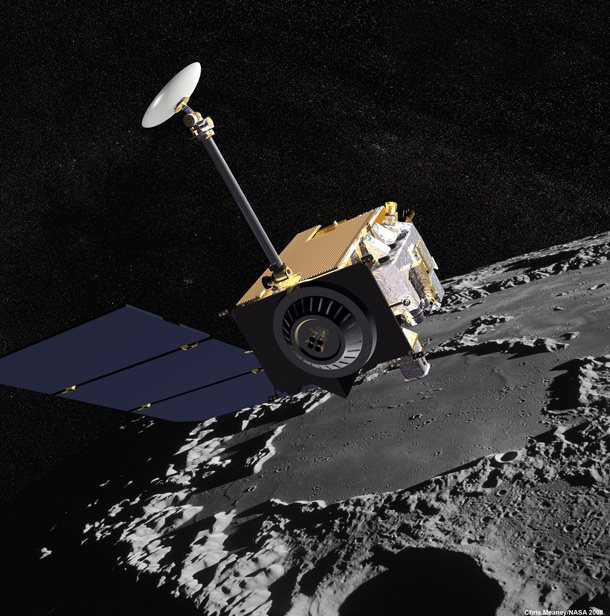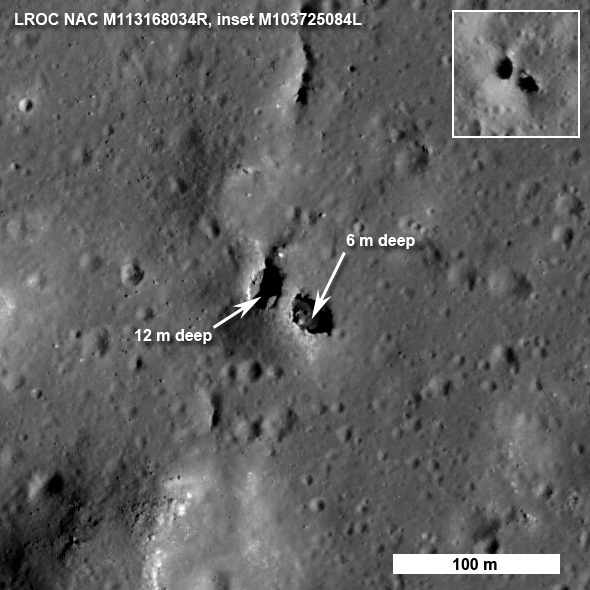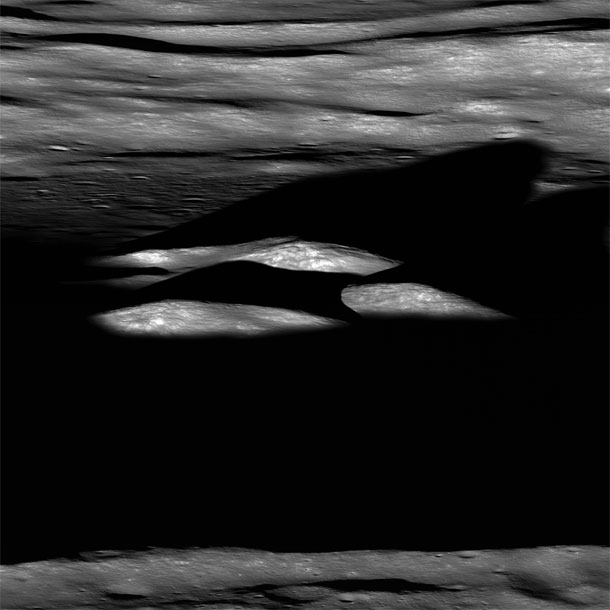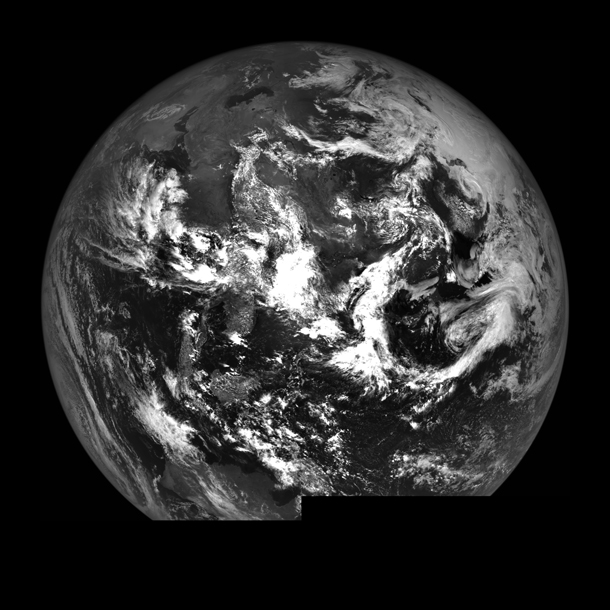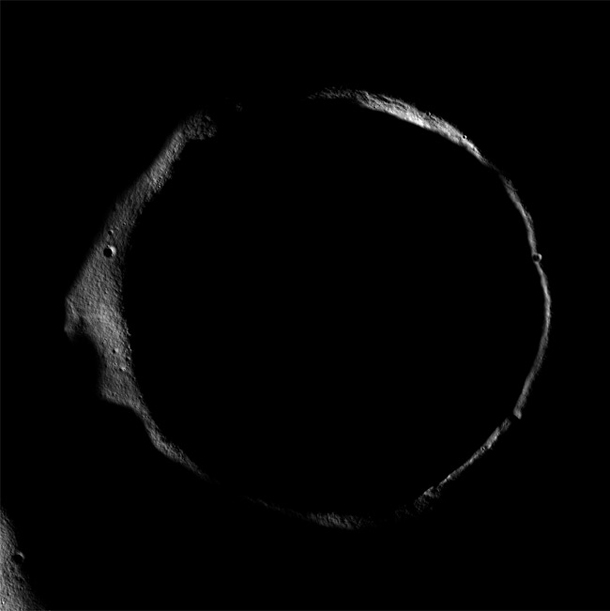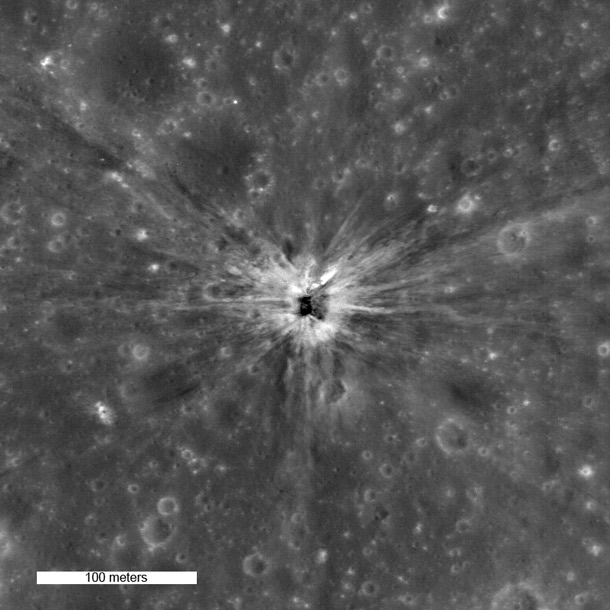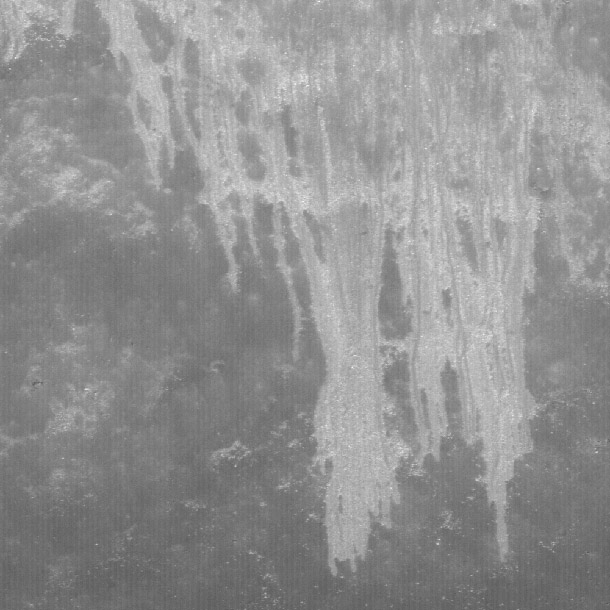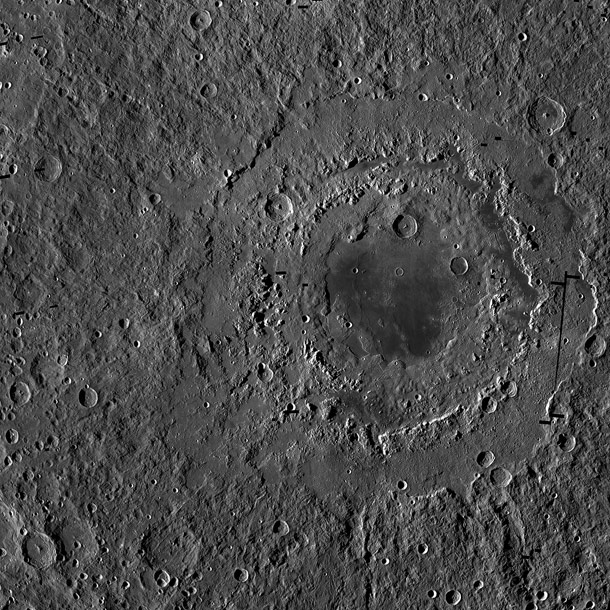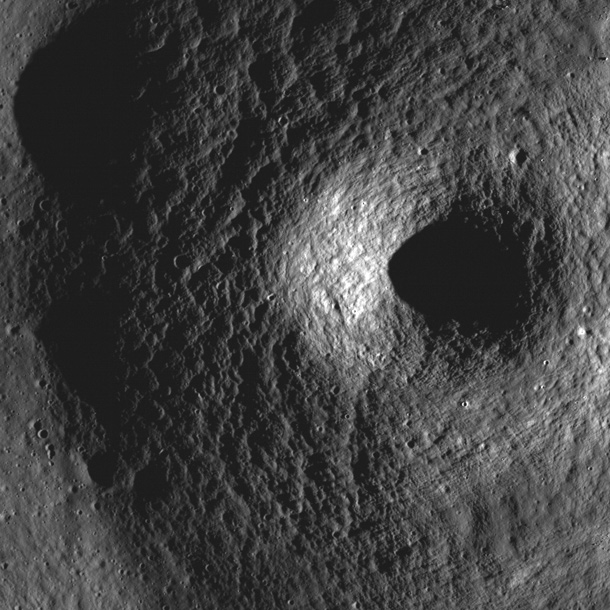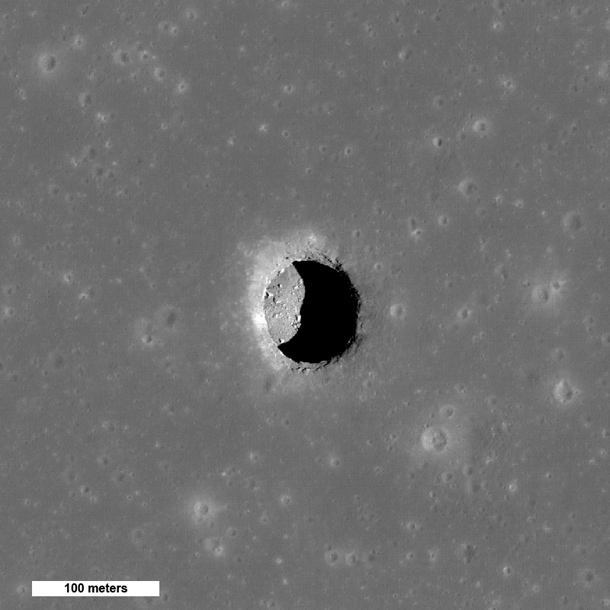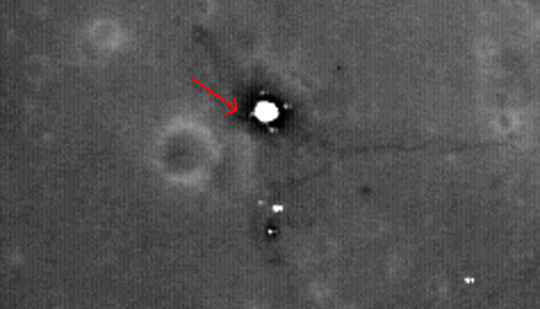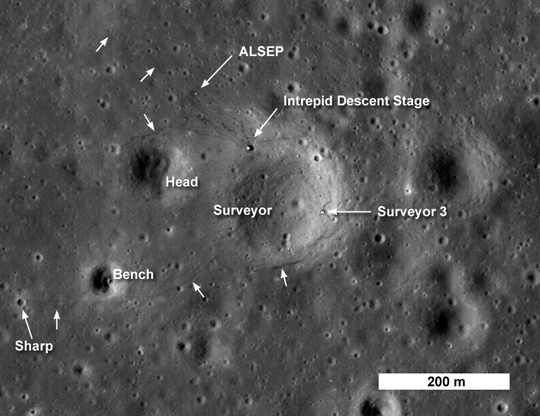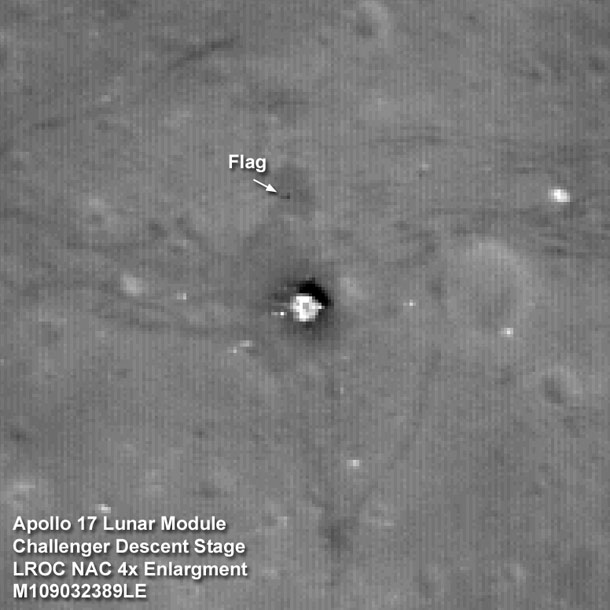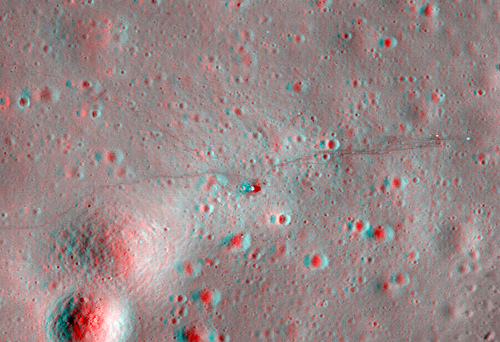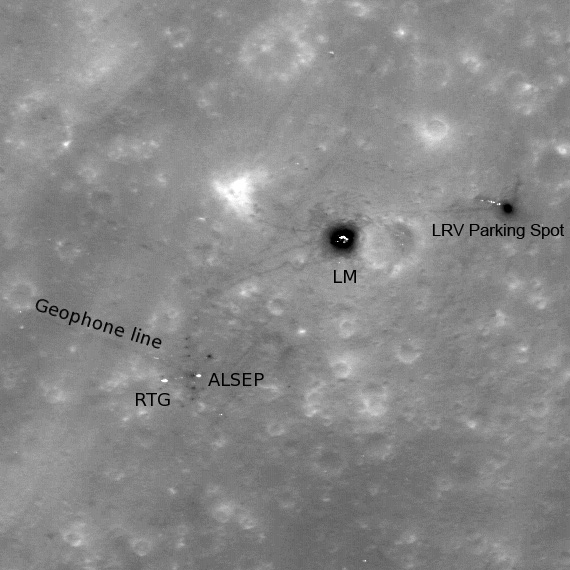Lunar craters, young and old
This is a pretty neat picture taken by the Lunar Reconnaissance Orbiter: two craters, side by side:
[Click to impactenate.]
What's cool about it is the obvious age discrepancy between the two craters. The Moon lacks water and air, but it has erosion nonetheless: micrometeorite impacts, solar wind, and even thermal stress cause by the month-long day night cycle slowly wears away at the surface. Old craters have a rounded look to them, while fresher craters are sharp-edged, and show the debris from impact.
The full-res image has a scale of just a meter per pixel, so a lot of the smaller boulders you see around the younger crater on the right are the size of cars. Both craters are roughly 300 or so meters across; you could walk briskly across them in a couple of minutes.
I noticed the young crater has an odd shape, non-circular, almost diamond-shaped. Then I looked at other, nearby craters, and saw the same thing, so it must mostly be due to lighting. However, there is a funny hillock just to the right of the crater, and the boulder field around it is not symmetric; there are more above and below it. I wonder if there is a density change in the underlying rock just to the right of the crater, which helped shape the crater...?
That area is mostly flat lava flood plains, and in the zoomable and pannable larger-area context image there are some interesting features that look like very old crater rims poking up through the plain. Check it out! One of my favorite things about LRO is the pile of high-res pictures like this one you can zoom in an out of. It really helps give you a feel for what you're seeing.
[Below is a gallery from some of my favorite pictures from LRO.]
Bad Astronomy Gallery
(click any image to see it full size)
In honor of this milestone, I have collected a few of my favorite LRO pictures from the past year and put them together in this gallery; use the "filmstrip" at the top of this post to see them all.
We've been observing the Moon for thousands of years, but it wasn't until LRO that we started to get a comprehensive and extreme close-up view of this neighboring world. Remember, when you look at these pictures you're seeing the Moon from a camera just 50 km (30 miles) above the surface, with a resolution of half a meter (18 inches!). The exploration phase of LRO has been nothing short of amazing; what will the science phase bring?
All image credits: NASA, NASA/GSFC/Arizona State University
To be honest, no one knows. It's sitting in the "impact melt" from King crater, a region where the entire area was liquified from the impact. It's possible that lava tubes or cavities formed at that time as the molten rock solidified into a crust. Pockets could've formed, and then part of the roof caved in to leave this 20-meter-long bridge.
Amazingly, the same strip imaged from LRO shows a second such bridge, too! Whatever happened at the crater happened more than once... meaning it may have happened at other craters as well. One thing I know for sure, the more we examine LRO images, the more surprises we'll find.
More info: NASA's LRO Natural Bridge page
This odd picture is actually three mountains poking out of the center of a crater. Don't believe me? Then let's take a step back, shall we:

Aha! See it now? Those three mountains are actually the central peaks of the crater Bhabha, a 64 kilometer (40 mile) wide impact scar on the far side of the Moon. With really big impacts, the shock waves bounce around inside the crater bowl, making the rock flow like a fluid. The rock flows outward, then sloshes back inward, splashing up to form peaks. Usually there’s only one, but Bhaba has three.
LRO caught these peaks just before the slow lunar rotation brought sunset to them. One of the many things I love about LRO pictures: they're not just interesting scientifically, they're also lovely and artistic.
Original post: Lunar triple sunset
Having trouble figuring out which part of Earth is visible? Then check out this reference image NASA made to help out.
Original post: A living world, from 370,000 km away
In this case, that's the rim of the crater! The floor and surrounding region are in the dark, but the rim sticks up just high enough to catch a few rays. On the flip side, the floor of many craters near the poles of the Moon never see sunlight and are locked in eternal frigidness. There may be ancient ice locked up under those crater bottoms, which would be very useful for future colonists.
Original post: Lunar boreal halo
Some of the rays - the streaks of material blasted out of the crater from the impact - can be traced for over a kilometer! These are pretty violent events, and in fact were used by later missions to create moonquakes so that scientists could learn about the lunar structure. Seismographs placed on the surface by astronauts showed us that there are still some small moonquakes going on even today.
Original post: One of the newest craters on the Moon
What could have caused this? A more recent impact jarring the Moon? A moonquake? At the moment that's not clear. But it does give scientists a view of both the surface and what lies just below, so features like this are a bonus.
Also? It's just so cool!
Original post: LRO sees a landslide
On the LRO website you can zoom in on this amazing feature and spend a lot of time seeing how much damage was done.
Original post: Zoom in a HUGE lunar bullseye!
If this truly is a volcano, the last time it saw any action was when the Moon was much younger and more active. There are other features on the lunar surface that we're pretty sure are volcanoes, but it's still hard to tell from images like this. The only way to know for sure is to go there and see!
Original post: Ash hole on the Moon
The hole itself is also about 100 meters deep. If you were to fall in, it would take about 11 seconds to plummet to the floor, and despite the low gravity you'd impact at about 60 kph (40 mph). Any future astronauts wanting to explore such features - and they will, since these holes give access to parts of the Moon untouched for billions of years - they'd better bring very good spelunking gear!
Original blog post: There's a hole in the Moon!
I had to wait a few years, but man oh man, was it worth it! This picture shows the Apollo 11 lander, some of the equipment left behind by the astronauts, and you can even see their bootprints in the lunar dust!
And that red arrow? That points to the Lunar Modules's landing leg equipped with a ladder... and it's the one Neil Armstrong descended to become the first human in all of history to set foot on another world.
I still get chills thinking about. Amazing. I can't wait until we go back.
Original Post: One Giant Leap seen again
The Apollo 12 astronauts did in fact walk over to Surveyor. They were also able to remove some of its parts to return to Earth for study as well.
I have a wine label made in honor of Apollo 12, showing astronaut Al Bean holding a glass of wine. Years ago I got him to sign it, and it's one of my most cherished mementos.
Original post: LRO spots Apollo 12 footsteps
You can even see the pole's shadow. I don't think any of the original flags are still there; the merciless blast of ultraviolet light from the Sun should have long-ago disintegrated the nylon in the flags. Perhaps when we go back we'll see tri-colored dust at the poles' bases.
But even if the flags are gone, the accomplishment remains. We went to the Moon six times, and brought those men home safely again.
Original post: ... and the flag was still there
Original post: 3D Apollo!
While the lack of shadows makes craters harder to see, it actually accentuates where the dust was disturbed by the astronauts' activities. The lander is obvious, and even the last parking spot of the lunar rover!
Original post: Apollo 16 site snapped from orbit



